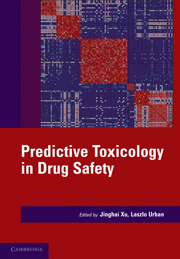Book contents
- Frontmatter
- Contents
- Contributors
- Prologue – Predictive toxicology: a new chapter in drug safety evaluation
- PREDICTIVE TOXICOLOGY IN DRUG SAFETY
- I SPECIFIC AREAS OF PREDICTIVE TOXICOLOGY
- II INTEGRATED APPROACHES OF PREDICTIVE TOXICOLOGY
- 10 Integrated approaches to lead optimization: improving the therapeutic index
- 11 Predictive toxicology approaches for small molecule oncology drugs
- 12 Mechanism-based toxicity studies for drug development
- 13 Fish embryos as alternative models for drug safety evaluation
- 14 The role of genetically modified mouse models in predictive toxicology
- 15 Toxicogenomic and pathway analysis
- 16 Drug safety biomarkers
- 17 Application of TK/PD modeling in predicting dose-limiting toxicity
- 18 Prediction of therapeutic index of antibody-based therapeutics: mathematical modeling approaches
- 19 Vaccine toxicology: nonclinical predictive strategies
- Epilogue
- Index
- Plate section
- References
19 - Vaccine toxicology: nonclinical predictive strategies
from II - INTEGRATED APPROACHES OF PREDICTIVE TOXICOLOGY
Published online by Cambridge University Press: 06 December 2010
- Frontmatter
- Contents
- Contributors
- Prologue – Predictive toxicology: a new chapter in drug safety evaluation
- PREDICTIVE TOXICOLOGY IN DRUG SAFETY
- I SPECIFIC AREAS OF PREDICTIVE TOXICOLOGY
- II INTEGRATED APPROACHES OF PREDICTIVE TOXICOLOGY
- 10 Integrated approaches to lead optimization: improving the therapeutic index
- 11 Predictive toxicology approaches for small molecule oncology drugs
- 12 Mechanism-based toxicity studies for drug development
- 13 Fish embryos as alternative models for drug safety evaluation
- 14 The role of genetically modified mouse models in predictive toxicology
- 15 Toxicogenomic and pathway analysis
- 16 Drug safety biomarkers
- 17 Application of TK/PD modeling in predicting dose-limiting toxicity
- 18 Prediction of therapeutic index of antibody-based therapeutics: mathematical modeling approaches
- 19 Vaccine toxicology: nonclinical predictive strategies
- Epilogue
- Index
- Plate section
- References
Summary
INTRODUCTION
Vaccines are one of the safest and most effective preventative treatments against infectious diseases. The first vaccine was against smallpox, and developed by Edward Jenner (1796) as a simple preparation of crude vaccinia. Today's vaccines are composed of a diverse range of products, which may include live attenuated or inactivated bacteria, virus or parasites, living irradiated cells, crude fractions or purified parts of microorganisms, polysaccharides, toxoids, recombinant proteins/polypeptides, and vector-based and DNA vaccines. Formulations may include novel adjuvants, excipients, and multiple antigen combinations and be delivered by novel routes via viral vectors or new delivery systems. Vaccines also offer wider possibilities with the promise of therapeutic benefit against various disorders such as cancer, prevention or treatment of immune-mediated diseases, and antismoking therapy.
Vaccines have an exemplary safety record, with a benefit that is immeasurable. With today's risk-averse society and heightened awareness, vaccine safety attracts intense scrutiny, particularly in the case of preventative vaccines, which are given to healthy adults, infants, and children. The safety benefit ratio is skewed heavily toward safety and as many infectious diseases are not prevalent today, many people may not perceive the benefit. In fact, in recent years, there has been a shift toward a risk benefit for the individual, and as a result of certain alleged safety issues, there has been a reduction in vaccinations, (e.g., Japan and DTP vaccines, MMR in UK, polio in African regions); this will ultimately lead to decreased herd immunity, and the prevalence of certain diseases may return.
- Type
- Chapter
- Information
- Predictive Toxicology in Drug Safety , pp. 344 - 370Publisher: Cambridge University PressPrint publication year: 2010



